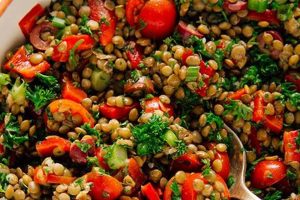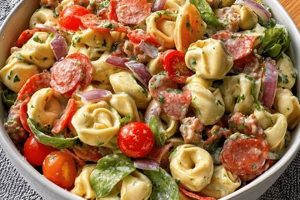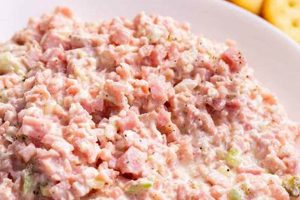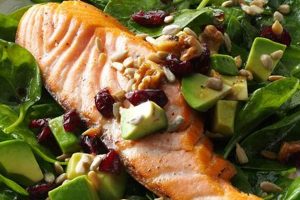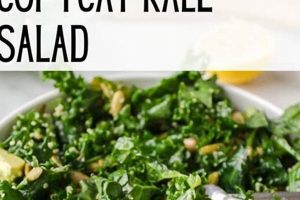A superior salmon salad hinges on high-quality ingredients and a balanced blend of flavors. Typically, this involves flaked cooked salmon combined with mayonnaise, finely diced celery and onion, and seasonings like dill, lemon juice, salt, and pepper. Variations may include additions such as capers, chopped hard-boiled eggs, or different herbs. A well-executed version offers a light yet satisfying meal or appetizer.
Achieving a flavorful and texturally appealing dish is paramount. Fresh, properly cooked salmon provides the foundation, while the other components contribute complementary tastes and textures. Historically, salmon salads have evolved from simple preparations using canned salmon to more elaborate recipes featuring fresh, often grilled or poached, fish. This progression reflects a broader culinary shift toward valuing fresh, high-quality ingredients and nuanced flavor profiles. Such a dish offers a good source of protein and omega-3 fatty acids, making it a nutritious choice.
The following sections will explore key aspects of creating an exceptional salmon salad, covering topics such as ingredient selection, preparation techniques, variations, and serving suggestions. This information will empower readers to confidently craft their own delicious versions.
Tips for an Exceptional Salmon Salad
Creating a truly remarkable salmon salad requires attention to detail and a thoughtful approach to ingredient selection and preparation. The following tips offer guidance on achieving superior results.
Tip 1: Start with High-Quality Salmon: Opting for fresh, sustainably sourced salmon is crucial. Whether wild-caught or farmed, the fish should exhibit a vibrant color and firm texture. Properly cooked salmon, whether baked, poached, or grilled, forms the foundation of a flavorful salad.
Tip 2: Mindful Ingredient Preparation: Finely dicing celery and onions ensures even distribution of flavor and a pleasant texture. Overly large pieces can overwhelm the delicate salmon.
Tip 3: Balance Moisture and Flavor: Mayonnaise is the classic binder, but its quantity should be carefully considered. Too much can result in a heavy, overly rich salad. Greek yogurt or a combination of mayonnaise and yogurt can offer a lighter alternative.
Tip 4: Seasoning is Key: Fresh dill, lemon juice, salt, and pepper are essential seasonings. Experimenting with other herbs and spices, such as chives, parsley, or a touch of cayenne pepper, can add complexity and depth.
Tip 5: Consider Textural Variety: Adding chopped hard-boiled eggs or capers introduces textural contrast. These ingredients also contribute additional flavor dimensions.
Tip 6: Chill Thoroughly: Allowing the salmon salad to chill for at least 30 minutes before serving allows the flavors to meld and enhances the overall experience.
Tip 7: Serve Thoughtfully: Salmon salad can be enjoyed in various ways, from classic sandwiches and lettuce wraps to crackers or as a filling for deviled eggs. Choosing the right accompaniment further elevates the dish.
By adhering to these tips, one can consistently produce a salmon salad that is both flavorful and visually appealing. The combination of fresh ingredients, careful preparation, and balanced seasoning yields a dish that satisfies.
The culmination of these elements results in a salmon salad experience that transcends the ordinary.
1. Fresh, High-Quality Salmon
The foundation of a truly exceptional salmon salad rests upon the quality of its primary ingredient: fresh, high-quality salmon. This core component dictates the overall flavor, texture, and nutritional value of the final dish. Understanding the nuances of salmon selection is paramount in achieving optimal results.
- Sourcing and Sustainability:
Responsibly sourced salmon, whether wild-caught or farmed using sustainable practices, contributes not only to a superior culinary experience but also to environmental well-being. Wild-caught salmon from reputable fisheries often exhibits a more pronounced flavor profile, while sustainably farmed salmon offers a consistent texture and milder taste. The source directly impacts the final dish’s flavor and ecological footprint.
- Indicators of Freshness:
Visual and olfactory cues are crucial in assessing salmon freshness. The flesh should appear vibrant and glistening, with a firm texture. A fresh, slightly salty aroma is characteristic of high-quality salmon, while any off-putting odors indicate spoilage. These indicators ensure the salad starts with pristine ingredients.
- Flavor and Texture Profiles:
Different species of salmon, such as King, Sockeye, and Coho, possess distinct flavor and texture profiles. King salmon is known for its rich, buttery flavor and large flakes, while Sockeye offers a firmer texture and a more pronounced salmon flavor. Choosing the appropriate species allows for tailoring the salad to specific preferences.
- Proper Handling and Storage:
Maintaining the cold chain from purchase to preparation is essential for preserving salmon’s freshness. Storing the fish at the appropriate temperature, preferably on ice or in the coldest part of the refrigerator, minimizes bacterial growth and maintains quality. Proper handling ensures the salmon remains optimal for consumption.
The selection of fresh, high-quality salmon profoundly influences the final outcome of the salad. Prioritizing responsibly sourced fish, recognizing indicators of freshness, understanding flavor profiles, and employing proper handling techniques are crucial steps in crafting a salmon salad that exemplifies culinary excellence. The attention given to this primary ingredient translates directly to the overall enjoyment and nutritional value of the finished dish.
2. Precise Ingredient Proportions
Achieving a harmonious balance of flavors in a salmon salad necessitates precise ingredient proportions. The delicate flavor of salmon can be easily overwhelmed by overly assertive additions, while insufficient quantities of complementary ingredients may result in a bland or one-dimensional dish. Careful consideration of ingredient ratios ensures that each component contributes to the overall flavor profile without overpowering the others.
- The Salmon-to-Binder Ratio:
The ratio of flaked salmon to the chosen binder (typically mayonnaise, Greek yogurt, or a combination) significantly impacts the salad’s texture and richness. Too much binder can create a heavy, overly creamy salad, while too little may result in a dry, crumbly mixture. The ideal ratio allows the salmon to remain the star, supported by a binder that provides creaminess and cohesion without masking the fish’s delicate flavor. For example, a ratio of 2:1 (salmon to binder) often provides a desirable balance.
- Aromatic Vegetables:
Finely diced celery and red onion are common aromatic additions that provide textural contrast and a subtle sharpness. However, excessive amounts can overpower the salmon. A general guideline is to use a smaller volume of these aromatics compared to the salmon, ensuring their flavors enhance rather than dominate. A ratio of 4:1 (salmon to combined aromatics) provides a balanced flavor profile.
- Seasoning and Acid:
Seasoning plays a crucial role in enhancing the salmon’s inherent flavor. Salt, freshly ground black pepper, and a touch of lemon juice or vinegar brighten the salad and balance the richness. Over-seasoning can mask the delicate salmon flavor, while insufficient seasoning can result in a bland dish. Careful tasting and adjustment are essential to achieve optimal balance.
- Additional Ingredients:
Ingredients such as capers, chopped hard-boiled eggs, or fresh herbs provide additional layers of flavor and texture. However, these additions should be used judiciously. A small amount of capers provides a briny, salty accent, while too many can overwhelm the palate. Similarly, fresh herbs should be added sparingly to enhance, not overpower, the salmon’s flavor.
Precise ingredient proportions are essential for achieving a well-balanced and flavorful salmon salad. Careful consideration of the ratio of salmon to binder, the quantity of aromatic vegetables, and the judicious use of seasonings and additional ingredients contribute to a harmonious blend of flavors and textures. The interplay of these elements elevates the dish from a simple mixture to a culinary creation that showcases the delicate nuances of fresh salmon.
3. Balanced Flavor Combinations
A truly exceptional salmon salad hinges on the harmonious interplay of flavors. Balance is paramount; no single ingredient should dominate, but rather contribute to a cohesive and nuanced flavor profile that enhances the inherent qualities of the salmon. Understanding how different flavor components interact is essential for crafting a superior salad.
- The interplay of richness and brightness:
Salmon possesses a natural richness, which can be complemented by bright, acidic elements. Lemon juice or vinegar cut through the richness, preventing the salad from becoming overly heavy. This acidity also helps to preserve the vibrant color of the salmon. The balance prevents palate fatigue and allows for full appreciation of each bite.
- The role of aromatics:
Aromatic vegetables such as finely diced celery and red onion contribute savory notes and textural complexity. These ingredients should be used judiciously, providing subtle complexity without overpowering the salmon. Their pungency offers a counterpoint to the richness of the fish, further enhancing the overall balance.
- Herbaceous accents:
Fresh herbs introduce another layer of flavor complexity. Dill, chives, and parsley are classic choices, each offering a distinct character. Dills subtle anise notes pair particularly well with salmon, while chives provide a mild onion flavor, and parsley offers a fresh, slightly peppery taste. The choice of herbs can significantly influence the final flavor profile, and restraint is key to prevent overpowering the other components.
- Textural considerations:
Texture plays a significant role in flavor perception. The creamy texture of the binder, the flakiness of the salmon, and the crispness of the vegetables create a dynamic sensory experience. The interplay of textures adds another dimension to the overall enjoyment of the salad, contributing to a more satisfying and complex culinary experience.
A well-balanced salmon salad is a testament to the careful consideration of flavor interactions. The interplay of richness and brightness, the judicious use of aromatics, the subtle integration of herbs, and the interplay of textures all contribute to a final product that is greater than the sum of its parts. This harmonious balance elevates the salmon salad from a simple dish to a culinary expression of nuanced flavor.
4. Appropriate Texture and Consistency
Texture and consistency are critical factors in a superior salmon salad, impacting both enjoyment and overall quality. The ideal salad exhibits a balance between the flaky tenderness of the salmon and the creamy richness of the binder, complemented by the contrasting crispness of vegetables. Achieving this harmonious interplay of textures elevates the sensory experience.
- Flake Size and Uniformity:
Overly large or uneven salmon chunks create a disjointed texture, detracting from the overall enjoyment. Conversely, excessively small or shredded pieces lack textural presence. Aiming for uniformly sized flakes, roughly the size of a thumbnail, provides an optimal balance, ensuring each bite contains a pleasing combination of salmon and other ingredients. This uniformity allows for even distribution of flavor and contributes to a more refined presentation.
- Binder Selection and Proportion:
The choice and quantity of binder directly influence the salad’s consistency. Mayonnaise is a classic choice, offering a rich, creamy texture. Greek yogurt provides a lighter, tangier alternative, while a combination of both can achieve a balance of richness and tang. The correct proportion ensures the binder coats the salmon and other ingredients without creating an overly heavy or greasy mouthfeel. An excess of binder can mask the delicate flavor of the salmon, while too little results in a dry, crumbly texture.
- Vegetable Crispness and Size:
The addition of crisp vegetables such as celery and red onion provides textural contrast. These vegetables should be finely diced to ensure even distribution and prevent overpowering the salmon. Maintaining their crispness contributes to a refreshing and dynamic mouthfeel. Overly large pieces can disrupt the balance, while soft or wilted vegetables detract from the desired textural contrast.
- Moisture Content:
A well-executed salmon salad possesses a desirable level of moisture, neither too dry nor too wet. Excess moisture can dilute the flavors and create a watery consistency. Conversely, insufficient moisture results in a dry, unappetizing texture. Properly draining the salmon after cooking and carefully incorporating the binder helps to achieve the ideal moisture balance. This balance is essential for delivering a palatable and enjoyable sensory experience.
The interplay of these textural elements significantly contributes to a positive culinary experience. Careful attention to flake size, binder selection and proportion, vegetable crispness, and overall moisture content elevates the salmon salad beyond a simple mixture of ingredients. The resulting harmonious blend of textures enhances the enjoyment and underscores the quality of the final dish. A properly textured salmon salad demonstrates culinary expertise and attention to detail, highlighting the importance of textural balance in achieving a truly exceptional result.
5. Proper Chilling and Storage
Proper chilling and storage are integral to a high-quality salmon salad, impacting both food safety and flavor optimization. Chilling allows the flavors to meld, enhancing the overall taste profile. More importantly, it inhibits bacterial growth, ensuring the salad remains safe for consumption. Failure to adhere to proper chilling practices can lead to spoilage and potential foodborne illness. For instance, leaving the prepared salad at room temperature for extended periods, especially in warmer climates, creates a breeding ground for bacteria. Conversely, prompt and thorough chilling preserves freshness and minimizes risk.
The chilling process itself influences the final dish. Immediate chilling after preparation prevents the mayonnaise or other binder from breaking down, maintaining the desired creamy texture. Furthermore, chilling allows the flavors of the various ingredients, such as herbs, spices, and vegetables, to permeate the salmon, creating a more complex and unified flavor profile. This crucial step transforms a simple mixture of ingredients into a cohesive culinary creation. Practical applications of this understanding include refrigerating the salad in a covered container for at least 30 minutes before serving, ensuring it remains chilled during transport or outdoor events, and storing leftovers promptly at the correct temperature to maintain quality and safety.
In summary, proper chilling and storage are not merely afterthoughts but essential steps in crafting a truly exceptional salmon salad. This practice directly influences flavor development, texture preservation, and, critically, food safety. Neglecting this aspect compromises both the quality and safety of the dish, underscoring the importance of integrating proper chilling and storage into every stage of preparation and service. Effective temperature control ensures a delightful and safe culinary experience, reinforcing the connection between proper food handling practices and the creation of a high-quality dish.
6. Creative Serving Presentations
Elevated presentation transforms a simple salmon salad into a memorable culinary experience. While flavor and texture remain paramount, visual appeal significantly enhances enjoyment. Consideration of serving vessels, accompaniments, and garnishes elevates the perceived value and overall satisfaction. A thoughtfully plated salad demonstrates attention to detail and culinary expertise, transforming a basic dish into a sophisticated offering. This connection between presentation and perceived quality underscores the integral role of creative serving in achieving a truly exceptional result.
Practical applications abound. Serving the salad on crisp lettuce cups offers a light, refreshing alternative to bread. Utilizing endive spears or cucumber rounds adds a touch of elegance and textural contrast. For a more substantial presentation, toasted baguette slices or croissant halves provide a buttery, flaky counterpoint to the creamy salmon salad. Garnishing with fresh dill sprigs, lemon wedges, or a sprinkle of paprika enhances visual appeal and reinforces flavor profiles. These examples demonstrate how thoughtful presentation elevates the dining experience, contributing to a more memorable and satisfying meal.
In conclusion, creative serving presentations are essential to achieving a “best” designation. While a delicious salmon salad forms the foundation, innovative presentation enhances its perceived value and overall enjoyment. The considered selection of serving vessels, accompaniments, and garnishes elevates the dish from simple fare to a refined culinary creation. This attention to detail distinguishes an ordinary salmon salad from a truly exceptional one, demonstrating the powerful interplay between visual appeal and culinary satisfaction. The effort invested in presentation directly correlates with the perceived quality of the dish, solidifying its position as a key component of a truly remarkable salmon salad experience.
Frequently Asked Questions
This section addresses common inquiries regarding the preparation and enjoyment of superior salmon salad.
Question 1: What type of salmon is best suited for salmon salad?
While various salmon species can be utilized, King, Sockeye, and Coho are generally preferred for their flavor and texture. King salmon offers a rich, buttery flavor, while Sockeye possesses a firmer texture and more pronounced salmon flavor. Coho provides a balance between the two. Canned salmon can also be used, but fresh salmon generally yields a superior result.
Question 2: How can one ensure the salmon is cooked properly for salad?
Proper cooking ensures optimal flavor and texture. Baking, poaching, or grilling are recommended methods. The salmon should be cooked until it reaches an internal temperature of 145F (63C) and flakes easily with a fork. Overcooking results in dry, less flavorful salmon.
Question 3: What can be used as a binder besides mayonnaise?
Greek yogurt offers a lighter, tangier alternative to mayonnaise. A combination of mayonnaise and Greek yogurt can also be used to achieve a balance of richness and tang. Avocado can be mashed and used for a healthier, creamier option.
Question 4: How long can salmon salad be stored in the refrigerator?
Properly stored in an airtight container, salmon salad can be refrigerated for up to three days. Beyond this timeframe, the risk of bacterial growth increases, potentially compromising both quality and safety.
Question 5: Can salmon salad be frozen?
Freezing is not generally recommended. Freezing can negatively impact the texture of the salmon and the consistency of the binder, resulting in a less desirable final product upon thawing.
Question 6: How can one elevate salmon salad beyond a basic preparation?
Incorporating high-quality ingredients, such as capers, fresh herbs, or a squeeze of lemon, enhances the flavor profile. Thoughtful presentation, including the choice of serving vessel and garnishes, further elevates the dish. Serving the salad on toasted brioche, in lettuce cups, or with crackers provides variety and visual appeal.
Addressing these frequently asked questions provides clarity on key aspects of salmon salad preparation, storage, and enjoyment. Attention to these details ensures a satisfying and safe culinary experience.
The following section offers a curated selection of recipe variations for those seeking to explore different flavor profiles and presentation styles.
Crafting the Best Salmon Salad Recipe
Achieving a truly exceptional salmon salad requires a multifaceted approach. From sourcing premium ingredients to mastering precise techniques, each step contributes to the final product. Careful consideration of flavor profiles, textural balance, and presentation elevates this seemingly simple dish to a culinary masterpiece. Prioritizing ingredient quality, employing proper chilling and storage methods, and understanding the delicate interplay of flavors and textures are crucial for consistent success. This comprehensive exploration has provided insights into the essential elements that define a superior salmon salad, emphasizing the importance of thoughtful preparation and execution.
The pursuit of the best salmon salad recipe is an ongoing culinary journey. Experimentation with diverse ingredients, flavor combinations, and presentation styles allows for personalized interpretations and the discovery of unique flavor profiles. By embracing these principles and continually refining techniques, culinary enthusiasts can consistently create salmon salads that delight the palate and exemplify culinary excellence. The potential for innovation remains boundless, encouraging exploration and the creation of truly exceptional and personalized variations.

